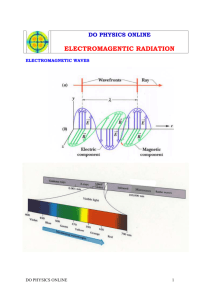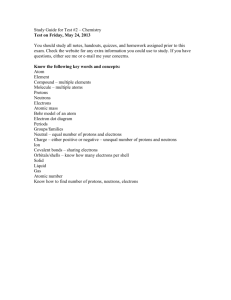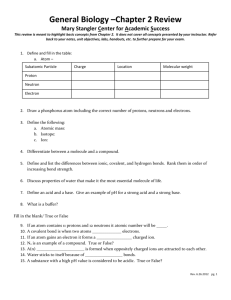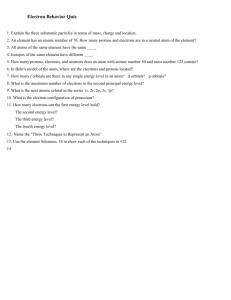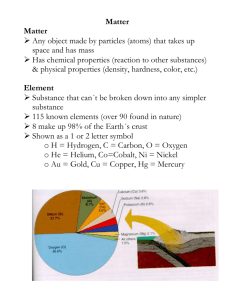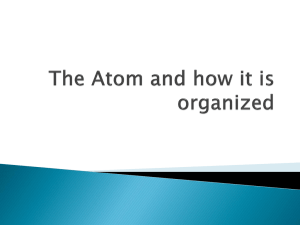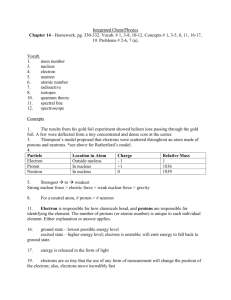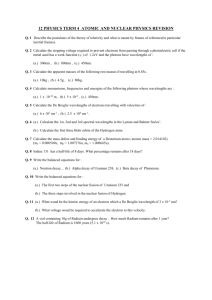Lecture 3
advertisement
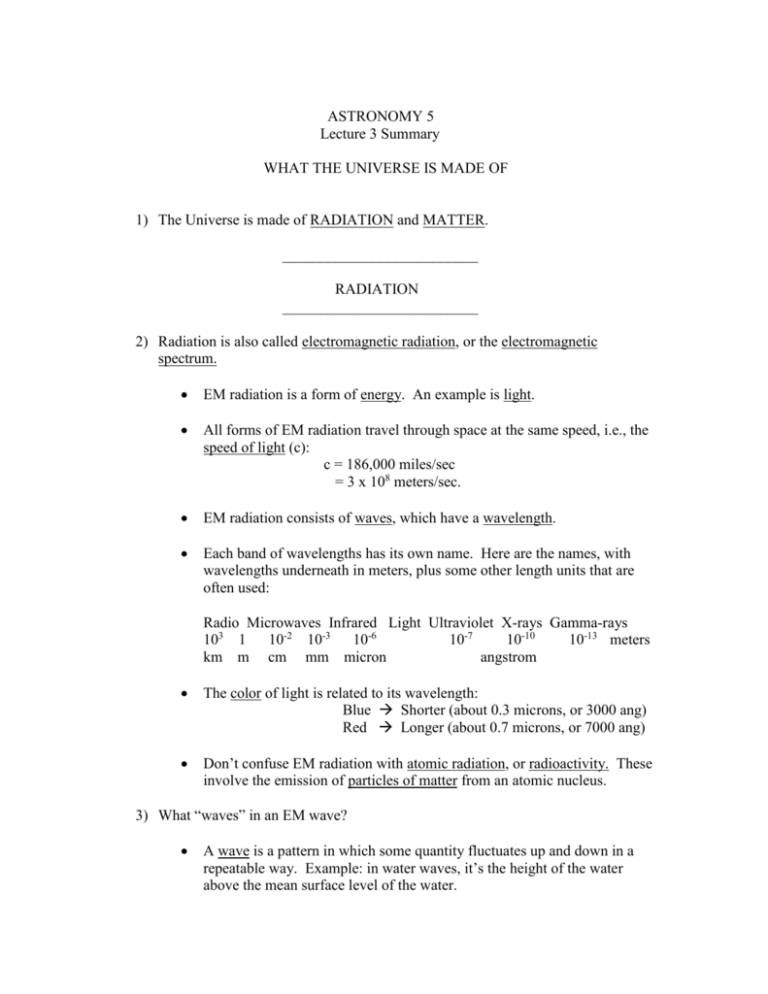
ASTRONOMY 5 Lecture 3 Summary WHAT THE UNIVERSE IS MADE OF 1) The Universe is made of RADIATION and MATTER. __________________________ RADIATION __________________________ 2) Radiation is also called electromagnetic radiation, or the electromagnetic spectrum. EM radiation is a form of energy. An example is light. All forms of EM radiation travel through space at the same speed, i.e., the speed of light (c): c = 186,000 miles/sec = 3 x 108 meters/sec. EM radiation consists of waves, which have a wavelength. Each band of wavelengths has its own name. Here are the names, with wavelengths underneath in meters, plus some other length units that are often used: Radio Microwaves Infrared Light Ultraviolet X-rays Gamma-rays 103 1 10-2 10-3 10-6 10-7 10-10 10-13 meters km m cm mm micron angstrom The color of light is related to its wavelength: Blue Shorter (about 0.3 microns, or 3000 ang) Red Longer (about 0.7 microns, or 7000 ang) Don’t confuse EM radiation with atomic radiation, or radioactivity. These involve the emission of particles of matter from an atomic nucleus. 3) What “waves” in an EM wave? A wave is a pattern in which some quantity fluctuates up and down in a repeatable way. Example: in water waves, it’s the height of the water above the mean surface level of the water. In an EM wave, there are actually two quantities that fluctuate: an electric field and a magnetic field. The two fields are perpendicular to each other. Snapshot of an EM wave frozen in space and time: 4) EM waves travel because the changing electric field pulls on the magnetic field, and vice versa. Each one creates the precise change in the other needed to reinforce itself. Yang and yin. A perfect marriagedeeply beautiful and profoundly mysterious. 5) Besides being wavelike, EM radiation sometimes also acts like a beam of particles. This paradox is called the WAVE-PARTICLE DUALITY OF LIGHT. Each particle of light is called a photon. Each photon has a specific energy given by its wavelength (): E = const. / , where the constant (Planck’s constant) is one of the fundamental constants of nature in our Universe. Don’t worry about the value of the constant. Just think: Short wavelengths Small Blue High-energy photons Long wavelengths Big Red Low-energy photons At long wavelengths, EM radiation behaves more like waves; at short wavelengths it behaves more like photon “bullets.” EM energy always comes in photon “packets,” each one of which is indivisible. __________________________ MATTER __________________________ 6) Matter refers to all forms of energy that have mass (photons do not have mass, but they do have energy). Matter always comes in the form of particles. Examples: Protons and neutrons Make atomic nuclei Electrons Orbit around nuclei Together, protons, neutrons, and electrons make up atoms. 7) Atoms come in different kinds depending on the number of protons and neutrons in the nucleus. The number of protons is more fundamental. Each number of protons makes a different element. Examples: 1 proton hydrogen 2 protons helium 6 protons carbon \ 8 protons oxygen | 26 protons iron, etc. / 75% of all matter in Universe 24% of all matter in Universe All else (1%) is “metals” like these. 8) Atoms are held together by the “+” charges of the protons attracting the “’’ charges of the electrons. If an atom has the same number of electrons as protons, there’s no net charge and the atom is neutral. If one or more of the electrons gets knocked off (by colliding with a loose electron, say), the atom is ionized. 9) The electrons in atoms are located in specific energy levels called “orbitals.” Inner levels have lower energy than outer ones. Photons of just the right energy can cause an electron to jump up from a lower level to a higher one, provided that Photon energy = the energy difference between orbitals (exactly). The photon’s energy gets “eaten” by the electron, and the photon is absorbed. This is how matter absorbs light, by having electrons move to higher energy levels. In reverse, a high-energy electron can fall down to a lower level by emitting a photon. Left alone, all the electrons in an atom will fall into the lowest levels permitted by the laws of atomic physics. This set of lowest levels is called the “ground state” of the atom. 10) Each kind of atom emits (or absorbs) its own pattern of wavelengths (colors), corresponding to all of its energy level differences. Each pattern is unique and therefore serves as a fingerprint for that element. By observing these patterns in the spectra of stars and other celestial bodies, we can tell what elements they are made of. 11) Other types of matter in the Universe: Antimatter: Each type of particle (electron, neutron, proton, etc.) has a mirror antiparticle (anti-electron, anti-neutron, anti-proton, etc.). The anti-particle is opposite in every way (e.g., charge) except for mass. The mass is the same. Particles and their anti-particles can annihilate one another to produce energy in the form of photons: Particle + anti-particle ===> annihilate ===> two photons!!! Dark matter: There is a lot of matter in the Universe, and we don’t know what it is. It doesn’t shine, and it hasn’t been detected in the laboratory. The going name for it is Dark Matter. It’s a major mysterymore on this later. About 90% of the matter in the Universe seems to be “dark.”
